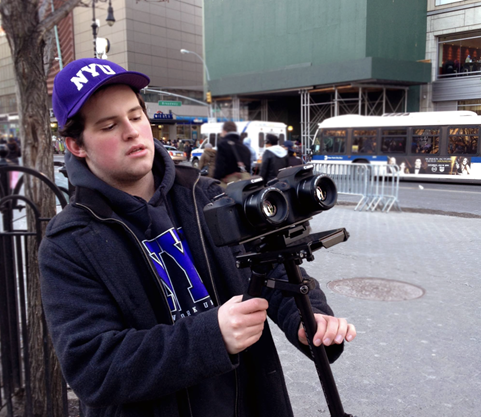This Century-Old Tech Might Be the Future of Media
Tech giants are betting on immersive video and reviving a century-old 3D illusion that might finally go mainstream.
NEW YORK CITY, NY / ACCESS Newswire / November 18, 2025 / As I escaped the crowds shuffling toward the Marie Antoinette exhibit at London's Victoria & Albert Museum, I wandered into the sparsely populated photography wing. In the center of the room sat a quiet cluster of stools, each outfitted with a pair of metal eyepieces, something like the coin-operated binoculars at the top of the Empire State Building.
Through the lenses appeared a sepia-toned stereograph of early 1900s Times Square. A snapshot from a world more than a century ago, rendered suddenly 3D. Everything appeared in perspective with a clear Z-axis: the carriages in the foreground jumping out as the buildings behind receded into a vanishing point. It was a dimensional window into history and also an unexpected reminder of my dormant fascination from over a decade ago.
My interest in the format began during a high school internship at a visual effects studio, where I was first introduced to stereoscopy. It is the technique of combining two slightly offset images to simulate depth, using the same principle our eyes rely on to perceive space: two perspectives, merged by the brain into a single depth-rich experience.
For my high school senior project, I wanted to film something in stereoscopic 3D, which was quite a challenge at the time. You needed two cameras perfectly aligned, and the rigs that made that possible were mostly reserved for large productions. So I improvised, strapping together a pair of bulky DSLRs with rails and clamps.
The setup was far from perfect. Without genlock (a way to sync the shutters), the two cameras were never exactly in step. And because of their size, I could not place the lenses close enough to match the interaxial distance, which is the spacing between human eyes that determines how natural the 3D effect feels. For viewing, I converted the footage into anaglyph format, the old red-and-blue glasses kind, and screened it for the class. The depth was exaggerated, the sync was off, but somehow, it still worked (at least enough to earn an A).
Stereoscopy is the foundation of modern immersive formats like virtual reality. You need a sense of depth, a believable illusion that you are "inside" a space, not just watching it. That same illusion can be created with nothing more than two carefully offset images.
I entered NYU Film School brimming with stereo enthusiasm. While most students were focused on directing the next indie drama, I was wandering around Union Square with a custom-built 3D rig, dreaming of a future where dimensional cinema would evolve into a true storytelling language.
I pitched an independent study focused on stereoscopic 3D narrative, hoping to explore how depth could shape emotion the way color or sound does. But when I presented the idea, one professor shot it down. "This isn't worth pursuing," he said, in front of everyone. I kept experimenting, earning the nickname "3D Steve," both as a curiosity and as a bit of a punchline.
At the time, I could not fully argue with the skepticism. 3D movies had been around for decades, and even when films like Gravity tapped into the zeitgeist with critical acclaim, most stereoscopic experiences were still plagued by cheap "pop-out" effects, uncomfortable glasses, and a lack of emotional purpose. Outside of theme parks, where audiences expected spectacle, stereoscopic 3D never found its footing as an expressive language. Few were using depth as a storytelling tool. It remained a niche curiosity, something I tinkered with, but could not find a clear application for.
Still, NYU gave me an incredible foundation and has become a leading investor in emerging media technologies. It is also where I met my future business partner, Michael Ayjian. We were both film students obsessed with the craft, constantly scheming our next project. Between classes and late-night edits, we co-founded 7 Wonders Cinema, a video marketing agency created to take on real-world client work and push the boundaries of brand storytelling.
For a while, my fascination with stereoscopic 3D faded in favor of more traditional formats. It felt too impractical for the kinds of projects we were landing. But in 2015, Google Cardboard started gaining traction. This low-cost viewing device turned any smartphone into a stereoscopic display. It was accessible, clever, and surprisingly effective. We happened to be uniquely positioned to act on this new enthusiasm.
7 Wonders began producing 3D video walkthroughs for high-end Manhattan real estate listings. These were immersive experiences that gave prospective buyers a true sense of space, depth, and layout. For the first time, stereoscopic 3D felt commercially viable in an accessible way for creators.
Still, it had limits. Google Cardboard may have unlocked viewing, but capture still required custom rigs, manual syncing, and a clunky post-production pipeline. And while the viewer was clever, it also felt disposable since it was quite literally cardboard. Ultimately, the results lacked emotional resonance.
So if we consider historical formats that do succeed in making us feel something, what sets them apart? Super 8, introduced in the 1960s, offers a compelling counterpoint. It was simply a compact, affordable film format that let everyday people capture everyday life. Birthdays. Vacations. First steps. But over time, its grainy warmth and gentle flicker, originally just technical limitations, became synonymous with memory itself.
Even today, filmmakers reach for Super 8 when they want something to feel lived-in and nostalgic. I chose it for my own wedding because it made the moment feel like a memory the instant it was captured. Maybe the reason stereoscopic 3D formats have struggled to feel emotional is simple: they have never been accessible enough for people to make their own memories with them.
Tech giants have been pushing the boundaries of augmented and virtual reality for years, with impressive technical achievements. But in recent months, certain leaders have quietly solved many of the longstanding barriers that once made stereoscopic video feel impractical. The have begun leveraging multiple cameras on the same mobile device to capture depth natively, without bulky rigs, manual syncing, or genlock required. New operating system updates now allow users to retroactively convert almost any existing 2D photo into a dimensional scene, complete with parallax effects that respond to device movement. And on the viewing side, they have moved well beyond flimsy cardboard viewers, introducing premium, immersive headsets that feel less like experiments and more like polished extensions of their broader ecosystems.
But the real innovation is not just technical. It is emotional. Some tech giants are intentionally shifting the language itself, rebranding niche technical terminology into something more human and resonant. They are positioning this dimensional video format not as a novelty, but as a way to feel closer to your memories, to relive a moment instead of simply watching it. Everyday people capturing everyday moments - birthdays, dinners, trips - are now being framed as immersive experiences worth stepping back into. If that association sticks, this technology could become synonymous with something deeply personal: presence, memory, and emotional connection. While some companies are taking a more immersive route through headsets, others are investing in lightweight, everyday wearables that blend digital graphics with the real world. The real breakthrough may lie in the convergence, a balance between immersion and accessibility, powered not just by hardware, but by branding that makes it feel inevitable.
A widespread acceptance of the stereoscopic format is the foundation for even more important developments beyond just entertainment. The technology has meaningful applications in healthcare, education, and training. But to realize their full potential, society first has to become comfortable with the format itself.
The company, Dopl Technologies, is a perfect example of the potential. We first interviewed them on our 7 Wonders podcast without realizing their connection to stereoscopic 3D. They are a healthcare technology company using robotics and haptics to allow remote clinicians to physically interact with patients from a distance. While their system currently operates on flat 2D displays, their future vision includes integrating stereoscopic 3D to expand what's possible in remote care. For that vision to become reality, the technology first needs broader cultural acceptance and adoption.
It cannot remain a niche, novelty, or gimmick. That is why a branding shift is so critical. It frames the medium not only as technical wizardry, but as something emotional and intimate, with the ability to transport its users. Major technology and entertainment players have already announced a foray into live event broadcasting using a new 180-degree stereoscopic format. In the near future, sports, concerts, and other live events may not simply be watched on a screen, but they could be experienced as if you were actually there, surrounded by the action.
Stereoscopic 3D has existed since the early days of photography. The effect worked then, just as it works now. So what changed? The story. The brands that succeed in reframing stereoscopic video from a passing novelty into a tool for capturing memories will be the ones that reap the biggest rewards. It is a move that echoes Don Draper's iconic pitch in Mad Men, where he renames Kodak's photo slide projector the "Carousel" to evoke nostalgia.
The stereoscope in that quiet corner of the museum is not just an old relic, it is the through-line. From homebrew camera rigs to life-saving therapies. From Super 8 reels to immersive video portraits. The dreamlike depth and uncanny intimacy of dimensional memory is finally poised to become a new cultural language of emotion. One we have been inching toward for over a century.
Stephen Skeel
[email protected]
https://www.7wonders.com/
SOURCE: 7 Wonders
Information contained on this page is provided by an independent third-party content provider. XPRMedia and this Site make no warranties or representations in connection therewith. If you are affiliated with this page and would like it removed please contact [email protected]



